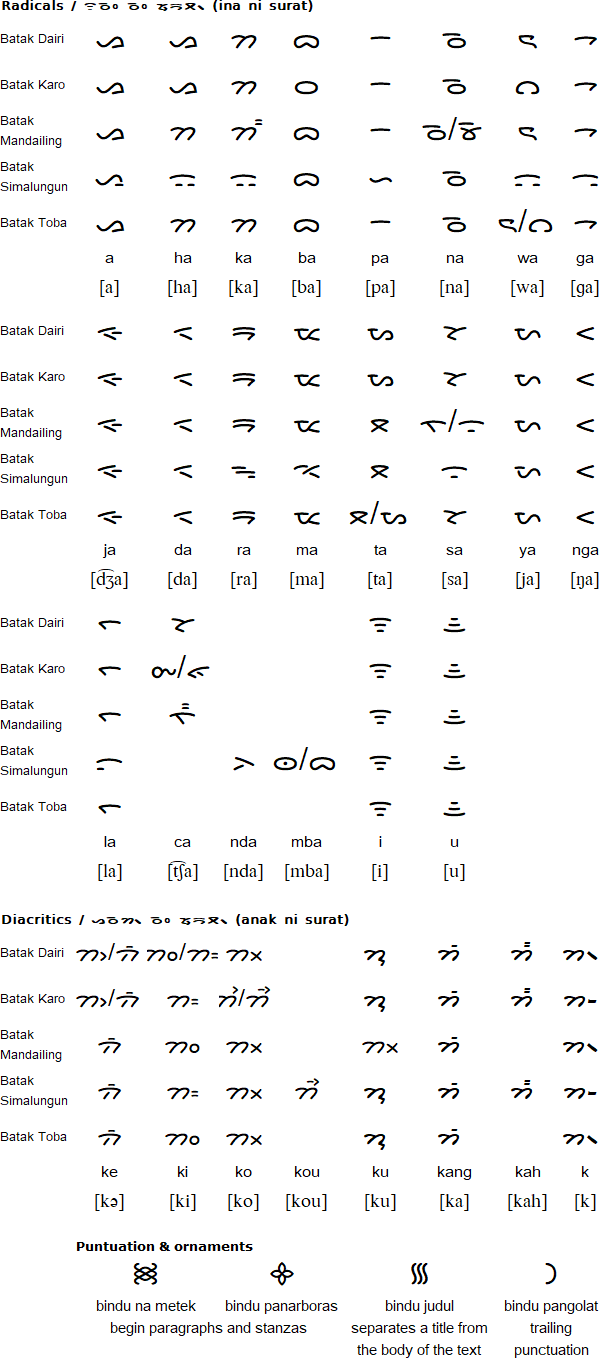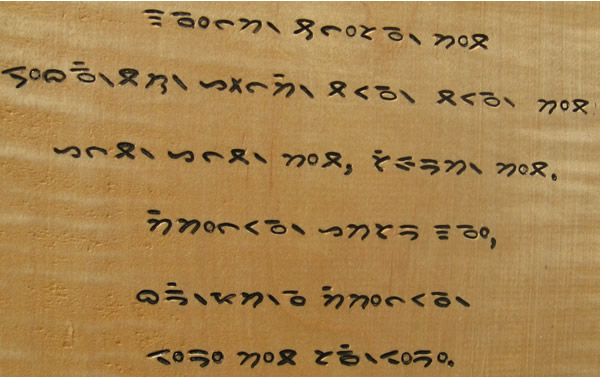The Batak script is used to write the Batal languages on the island of Sumatra in Indonesia. It is thought to be a descendent of the Pallava and Old Kawi scripts, which ultimately were derived from the Brahmi script of ancient India. Or it might be a descendent of a hypothetical Proto-Sumatran script, with Pallava influences.
Batak speakers call the script ᯘᯮᯒᯖ᯲ ᯅᯖᯂ᯲ (surat Batak), surat na sampulu sia ("the nineteen letters") or si-sia-sia.
Traditionally the Batak script was only used by datu (priests / healers / shamans). They made ink from resin soot and tree sap and made books of folded bark called pustaha, which contained knowledge, magic and calendars. They used a secret language, known as hata poda, which was also used in rituals around births, marriages and funerals.
It was also used by ordinary people for various purposes, including love letters, complaints, threatening letters, proverbs, sayings and lamentations. They incised it into bamboo, water buffalo bones or the bark of the Aquilaria tree with knives, then rubbed soot into the letters to make them more readable.
During the 1700s regional variations of the Batak script developed for each Batak language. After Europeans - first German missionaries, then the Dutch - began visiting Batak-speaking areas from 1878 the Batak script was taught in schools, along with the Roman alphabet, and teaching and religious material was published in the script.
Not long after the First World War missionaries decided to stop using the Batak script in books. Since then the script has been used mainly for decorative purposes.


Source: https://r12a.github.io/scripts/batk/btk.html

Inilah tulisan kita
dibentuk oleh tangan-tangan kita.
Alat-alta kita, sejarah kita.
Kehilangan aksara ini,
bermakna kehilangan diri kita sendir.
These are our words, shaped
By our hands, our tools,
Our history. Lose them
And we lose ourselves.
Translation and transliteration by Dr Mangantar Napitupulu. Carving and English text by Tim Brookes of endangeredalphabets.com
Information about: Batak script, Batak languages: Batak Angkola, Batak Dairi Batak Karo, Batak Mandailing, Batak Simalungun, Batak Toba | Phrases: Batak Toba | Numbers: Batak Toba | Tower of Babel in: Batak Angkola, Batak Dairi, Batak Karo, Batak Simalungun, Batak Toba
Information about the Batak script
http://en.wikipedia.org/wiki/Batak_script
https://aksara-batak.com/courses/batak-script-i/?lang=en
https://www.endangeredalphabets.net/alphabets/batak/
https://r12a.github.io/scripts/batk/btk.html
Batak fonts
https://ulikozok.com/aksara-batak/batak-font/
https://evertype.com/fonts/batak/
Batak Angkola, Batak Dairi, Batak Karo, Batak Mandailing, Batak Simalungun, Batak Toba
Ahom, Aima, Arleng, Badagu, Badlit, Basahan, Balinese, Balti-A, Balti-B, Batak, Baybayin, Bengali, Bhaiksuki, Bhujimol, Bilang-bilang, Bima, Blackfoot, Brahmi, Buhid, Burmese, Carrier, Chakma, Cham, Cree, Dehong Dai, Devanagari, Dham Lipi, Dhankari / Sirmauri, Ditema, Dives Akuru, Dogra, Ethiopic, Evēla Akuru, Fox, Fraser, Gond, Goykanadi, Grantha, Gujarati, Gunjala Gondi, Gupta, Gurmukhi, Halbi Lipi, Hanifi, Hanuno'o, Hočąk, Ibalnan, Incung, Inuktitut, Jaunsari Takri, Javanese, Kaithi, Kadamba, Kamarupi, Kannada, Kawi, Kharosthi, Khema, Khe Prih, Khmer, Khojki, Khudabadi, Kirat Rai, Kōchi, Kodava Lipi, Komering, Kulitan, Kurukh Banna, Lampung, Lanna, Lao, Lepcha, Limbu, Lontara/Makasar, Lota Ende, Magar Akkha, Mahajani, Malayalam, Meitei (Modern), Manpuri (Old), Marchen, Meetei Yelhou Mayek, Meroïtic, Masarm Gondi, Modi, Mon, Mongolian Horizontal Square Script, Multani, Nandinagari, Newa, New Tai Lue, Ojibwe, Odia, Ogan, Pahawh Hmong, Pallava, Phags-pa, Purva Licchavi, Qiang / Rma, Ranjana, Rejang (Kaganga), Sasak, Savara, Satera Jontal, Shan, Sharda, Sheek Bakrii Saphaloo, Siddham, Sinhala, Sorang Sompeng, Sourashtra, Soyombo, Sukhothai, Sundanese, Syloti Nagri, Tagbanwa, Tai Noi, Takri, Tamil, Tanchangya (Ka-Pat), Tani, Thaana, Telugu, Thai, Tibetan, Tigalari, Tikamuli, Tocharian, Tolong Siki, Vatteluttu, Warang Citi
Page last modified: 13.04.23
[top]
You can support this site by Buying Me A Coffee, and if you like what you see on this page, you can use the buttons below to share it with people you know.

If you like this site and find it useful, you can support it by making a donation via PayPal or Patreon, or by contributing in other ways. Omniglot is how I make my living.
Note: all links on this site to Amazon.com, Amazon.co.uk
and Amazon.fr
are affiliate links. This means I earn a commission if you click on any of them and buy something. So by clicking on these links you can help to support this site.
[top]